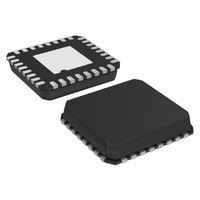ADA4410-6ACPZ-R7 Analog Devices Inc, ADA4410-6ACPZ-R7 Datasheet - Page 13

ADA4410-6ACPZ-R7
Manufacturer Part Number
ADA4410-6ACPZ-R7
Description
IC,TV/VIDEO CIRCUIT,TV/Video Filter,LLCC,32PIN,PLASTIC
Manufacturer
Analog Devices Inc
Type
Video Filterr
Datasheet
1.ADA4410-6ACPZ-RL.pdf
(16 pages)
Specifications of ADA4410-6ACPZ-R7
Applications
Recorders, Set-Top Boxes
Mounting Type
Surface Mount
Package / Case
32-LFCSP
Lead Free Status / RoHS Status
Lead free / RoHS Compliant
APPLICATIONS
OVERVIEW
With its high impedance multiplexed inputs and high output
drive, the ADA4410-6 is ideally suited to video reconstruction
and antialias filtering applications. The high impedance inputs
give designers flexibility with regard to how the input signals
are terminated. Devices with DAC current source outputs that
feed the ADA4410-6 can be loaded in whatever resistance
provides the best performance, and devices with voltage outputs
can be optimally terminated as well. The ADA4410-6 outputs
can each drive up to two source-terminated 75 Ω loads and can
therefore directly drive the outputs from set-top boxes, DVD
players, and the like without the need for a separate output buffer.
Binary control inputs are provided to select cutoff frequency,
throughput gain, and input signal. These inputs are compatible
with 3 V and 5 V TTL and CMOS logic levels, referenced to
GND. The disable feature is asserted by pulling the DISABLE
pin to the positive supply.
The LEVEL1 and LEVEL2 inputs comprise a differential input
that controls the dc level at the output pins.
MULTIPLEXER SELECT INPUTS
Selection between the two multiplexer inputs is controlled by
the logic signals applied to the MUX_SD and MUX_HD inputs.
The MUX_SD input controls the standard definition (SD)
inputs, and the MUX_HD input controls the high definition
(HD) inputs. Table 6 summarizes the multiplexer operation.
THROUGHPUT GAIN
The throughput gain of the ADA4410-6 signal paths can be ×2
or ×4. Gain selection is controlled by the logic signal applied to
the G_SEL pin. Table 6 summarizes how the gain is selected.
Composite Video Path Gain
The composite video signal is produced by passively summing
the C and V outputs (see Figure 1), which have been amplified
by their respective gain stages. Each signal experiences a 6 dB
loss as it passes through the passive summer and is subsequently
amplified by 6 dB in the fixed ×2 stage following the summer.
The net signal gain through the composite video path is therefore
0 dB, and the resulting composite signal present at the ADA4410-6
output is the sum of Y and C with unity gain. The offset voltage
at the composite video output is twice that of the offset on the Y
or C outputs because the offsets on the Y and C outputs are the
same and appear as a common-mode input to the summer. The
voltage between the summing resistors due to the offset voltages
is therefore equal to the output offset voltage on the Y and C
outputs and appears at the composite video output with a gain
of 2 after passing through the fixed ×2 gain stage.
Rev. B | Page 13 of 16
DISABLE
The ADA4410-6 includes a disable feature that can be used to
save power when a particular device is not in use. As indicated
in the Overview section, the disable feature is asserted by pulling
the DISABLE pin to the positive supply. Table 6 summarizes the
disable feature operation. The DISABLE pin also functions as a
reference level for the logic inputs and, therefore, must be
connected to ground when the device is not disabled.
Table 6. Logic Pin Function Description
DISABLE
V
Disabled
GND =
Enabled
CUTOFF FREQUENCY SELECTION
Four combinations of cutoff frequencies are provided for the
HD video signals. The cutoff frequencies were selected to
correspond with the most commonly deployed HD scanning
systems. Selection between the cutoff frequency combinations is
controlled by the logic signals applied to the F_SEL_A and
F_SEL_B inputs. Table 7 summarizes cutoff frequency selection.
Table 7. Filter Cutoff Frequency Selection
F_SEL_A
0
0
1
1
OUTPUT DC OFFSET CONTROL
The LEVEL1 and LEVEL2 inputs work as a differential input-
referred output offset control. In other words, the output offset
voltage of a given channel (with the exception of the CV
channel) is equal to the difference in voltage between the
LEVEL1 and LEVEL2 inputs multiplied by the overall filter
gain. This relationship is expressed in Equation 1.
where:
LEVEL1 and LEVEL2 are the voltages applied to the respective
inputs.
G is throughput gain.
For example, with the G_SEL input set for ×2 gain, setting
LEVEL1 to 300 mV and LEVEL2 to 0 V shifts the offset voltages
at the ADA4410-6 outputs to 600 mV. This particular setting
can be used in most single-supply applications to keep the
output swings safely above the negative supply rail.
S+
=
V
OS
(OUT) = (LEVEL1 − LEVEL2)(G)
F_SEL_B
0
1
0
1
MUX_HD
1 = HD Channel 1
Selected
0 = HD Channel 2
Selected
Y/G Cutoff
36 MHz
36 MHz
18 MHz
9 MHz
MUX_SD
1 = SD Channel 1
Selected
0 = SD Channel 2
Selected
Pb/B Cutoff
36 MHz
18 MHz
18 MHz
9 MHz
ADA4410-6
Pr/R Cutoff
36 MHz
18 MHz
18 MHz
9 MHz
G_SEL
1 = ×4
Gain
0 = ×2
Gain
(1)











